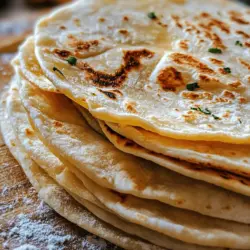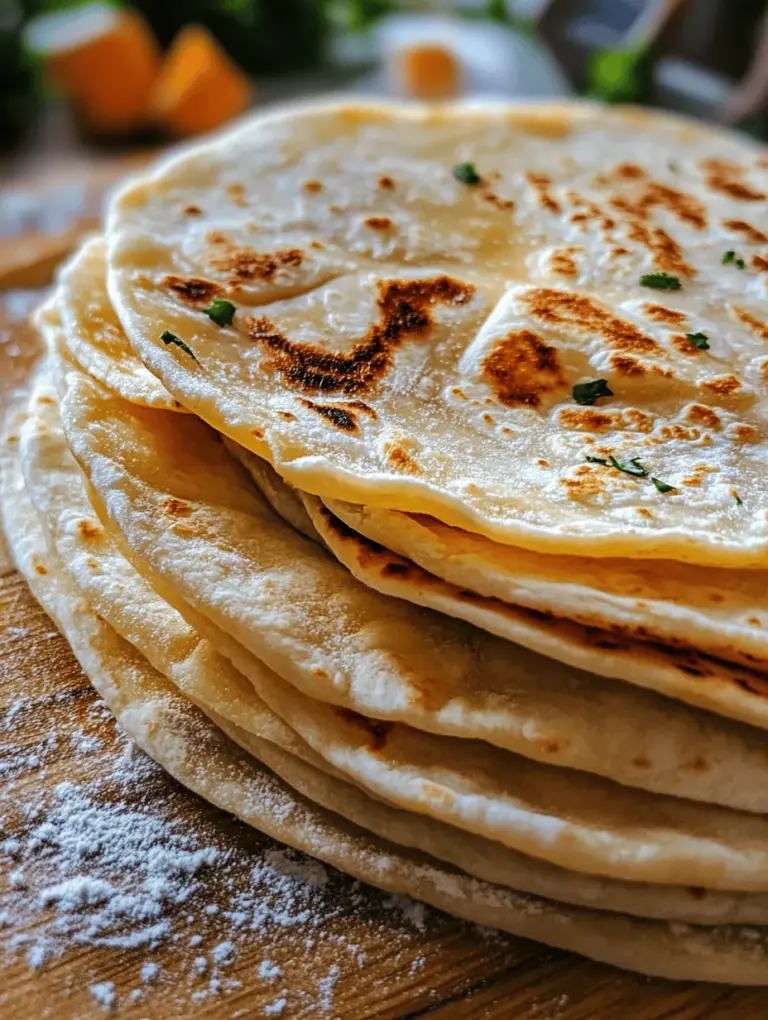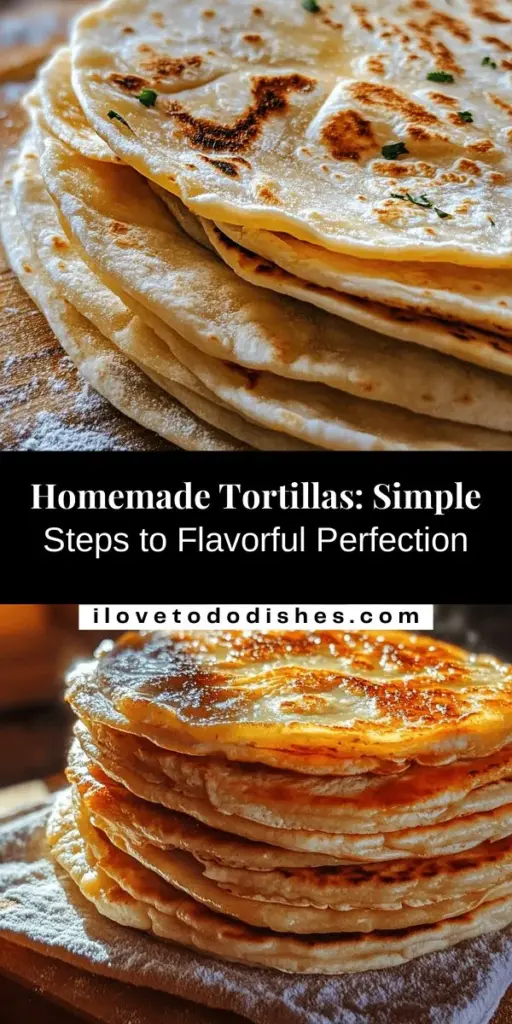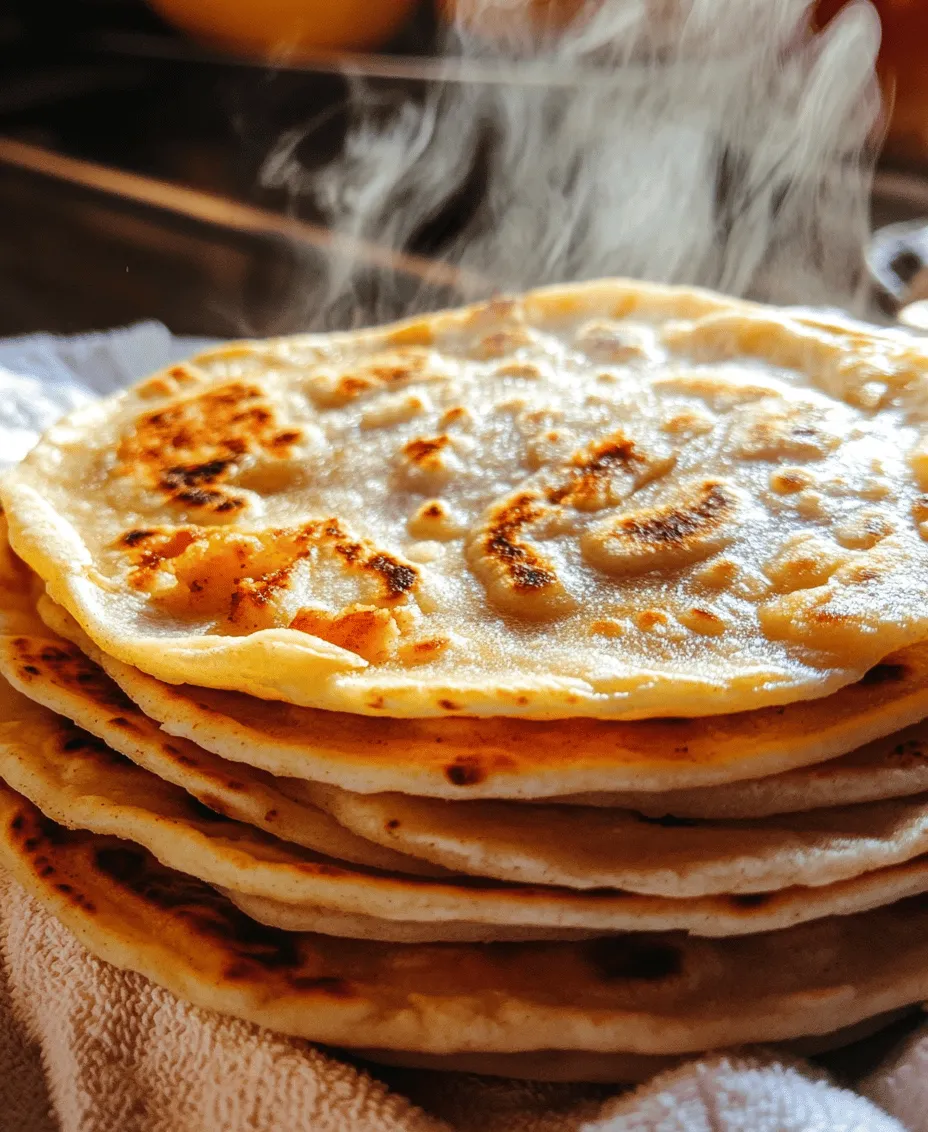Introduction
Tortillas are a fundamental staple in many cuisines around the world, but they hold a particularly revered status in Mexican cooking. These versatile flatbreads serve as the foundation for countless dishes, from tacos and enchiladas to burritos and quesadillas. While store-bought tortillas can be convenient, they often lack the freshness and rich flavor that homemade versions provide. The joy of making your own tortillas lies not just in the satisfaction of crafting something from scratch, but also in the incredible taste that comes from using quality ingredients and a little bit of technique.
In this guide, we will walk you through the process of creating the ultimate flavorful tortillas at home. The recipe is designed to be simple yet rewarding, ensuring that you can achieve delicious results even if you are a beginner in the kitchen. Get ready to elevate your cooking with tortillas that are not only full of flavor but also possess a delightful texture that enhances any meal.
Understanding Tortillas
The tortilla has deep-rooted historical significance in culinary traditions, particularly in Mexico, where it has been a staple food for thousands of years. Originally made from maize, tortillas have evolved into various forms and varieties that reflect regional ingredients and cooking techniques. The name “tortilla” itself stems from the Spanish word “torta,” meaning “cake,” which emphasizes its flat, round shape.
When it comes to tortillas, there are primarily two types: corn tortillas and flour tortillas. Corn tortillas are made from masa harina—a special type of corn flour—and are known for their distinct, earthy flavor and slightly chewy texture. They are often used in traditional dishes such as tacos, tamales, and enchiladas. Flour tortillas, on the other hand, are made from all-purpose flour and tend to be softer and more pliable, making them ideal for wrapping around fillings in burritos and quesadillas.
Both types of tortillas are not just delicious; they also offer nutritional benefits, especially when made from scratch. Homemade tortillas are free from preservatives and artificial ingredients often found in processed options, allowing you to control what goes into your food. Additionally, by using whole ingredients, you can maximize the nutritional value of your tortillas, incorporating fiber and healthy fats that are often lacking in store-bought varieties.
Key Ingredients for Flavorful Tortillas
Creating the ultimate flavorful tortillas requires a few essential ingredients that come together to form a cohesive and delicious dough. Here’s a closer look at each key component:
All-Purpose Flour
The foundation of flour tortillas is all-purpose flour, which plays a vital role in determining the texture and taste of the final product. It provides a light, tender quality that makes the tortillas easy to roll out and flexible enough to hold various fillings. For a more authentic flavor, consider using a mixture of all-purpose flour and whole wheat flour, which can add a nutty taste and additional nutrients.
Baking Powder
Baking powder is an important addition to the tortilla dough, helping to create lightness and a slight rise as they cook. This leavening agent ensures that the tortillas have a fluffy texture, preventing them from becoming overly dense. While some traditional recipes do not include baking powder, incorporating it can enhance the overall mouthfeel of the tortillas, making them more enjoyable to eat.
Salt
Salt is a crucial seasoning that enhances the flavor balance of the tortillas. It not only brings out the natural taste of the other ingredients but also contributes to the overall fermentation process of the dough. A pinch of salt can make a significant difference in the final product, ensuring that your tortillas are flavorful and satisfying.
Vegetable Oil or Lard
The choice of fat in your tortilla recipe will greatly influence the flavor profile and texture. Traditionally, lard is used in many Mexican recipes, imparting a rich taste that complements the other ingredients. However, for a vegetarian or healthier alternative, vegetable oil can also be used. Each option offers unique benefits, so choose based on your dietary preferences and desired flavor.
Warm Water
Warm water is essential in achieving the right consistency for your tortilla dough. It helps to activate the gluten in the flour, making the dough pliable and easy to work with. The temperature of the water can also affect the texture, so using warm water ensures that the dough comes together smoothly without becoming tough or dry.
Step-by-Step Instructions for Making Tortillas
Now that you are familiar with the key ingredients, let’s dive into the detailed step-by-step process for making your own flavorful tortillas at home. Each step is crucial for achieving that perfect balance of texture and taste.
1. Mixing Dry Ingredients
Start by measuring out your all-purpose flour and adding it to a large mixing bowl. It’s essential to ensure that the flour is evenly mixed with the baking powder and salt to create a uniform base for your dough. Using a whisk or fork, gently combine these dry ingredients until they are well incorporated. This step is vital, as it ensures that the baking powder is evenly distributed throughout the flour, allowing for consistent rising during cooking.
2. Adding Oil
Once the dry ingredients are uniformly mixed, it’s time to add the vegetable oil or lard. Using your fingers or a pastry cutter, work the fat into the flour mixture until it resembles coarse crumbs. This technique is important for creating a flaky texture in your tortillas. The goal is to evenly distribute the fat, which will help in achieving that tender, soft bite you’re looking for in the final product.
3. Incorporating Water
Next, you will gradually add warm water to the flour mixture. Begin by pouring a small amount of water into the bowl, mixing it with the flour as you go. It’s crucial to assess the dough consistency as you add the water. You want the dough to be moist but not sticky. If the mixture feels too dry, add a few more tablespoons of water, mixing until the dough comes together. Conversely, if it’s too wet, you can add a little more flour to adjust the consistency.
4. Kneading the Dough
Once your dough has come together, transfer it to a clean, lightly floured surface to knead. Kneading is an essential step that develops the gluten in the flour, resulting in a dough that is elastic and easy to roll out. Use the palms of your hands to push the dough away from you, then fold it back over itself. Repeat this process for about 5-10 minutes until the dough is smooth and supple. If the dough feels too sticky, sprinkle a bit of flour on the surface as needed. Kneading properly will ensure that your tortillas have the right texture and are easy to work with in the next stages.
By following these initial steps, you will create a solid foundation for your flavorful tortillas. The next part of this guide will delve into rolling and cooking your tortillas, so stay tuned for the continuation of this delicious journey.
Resting the Dough
Resting the dough is a crucial step in creating the ultimate flavorful tortillas. When you mix flour and water, you activate the gluten in the flour, which can make the dough tough if not given enough time to relax. Allowing the dough to rest for at least 30 minutes helps the gluten strands to unwind, resulting in a more pliable dough that is easier to roll out. This relaxation also improves the texture of the tortillas, making them softer and more enjoyable to eat.
To rest the dough, simply cover it with a damp cloth or plastic wrap to prevent it from drying out. This step is essential for achieving that perfect balance of elasticity and tenderness that will make your tortillas stand out.
Dividing and Shaping
Once your dough has rested, it’s time to divide and shape it into individual portions. A good practice is to weigh the dough to ensure uniformity in size, which will help your tortillas cook evenly. Each portion should be approximately 1.5 to 2 ounces, depending on how large you want your tortillas to be.
To shape the dough, start by flattening each portion between your palms to form a small disc. This initial shaping helps to make rolling easier. If you’re looking for perfectly round tortillas, use a bench scraper to keep your work surface tidy. This tool is also handy for transferring the shaped tortillas to the cooking surface later on.
Rolling Out Tortillas
Rolling out tortillas can be an art form in itself. To achieve perfect circles and the desired thickness, use a rolling pin or a tortilla press. If using a rolling pin, start from the center of the disc and roll outwards, rotating the dough a quarter turn after each roll. This method helps keep the shape consistent and prevents the tortillas from becoming too thick in one area.
Aim for a thickness of about 1/8 inch or less. Thinner tortillas cook faster and are more pliable, making them better for wrapping around fillings. If you find your dough is sticking to the surface, lightly dust it with flour to prevent this. However, be cautious not to over-flour, as this can affect the texture of the tortilla.
Cooking Tortillas
Cooking your tortillas is where the magic happens. Preheat a cast-iron skillet or a flat griddle over medium-high heat. The key to achieving the ideal cook is heat control; your skillet should be hot enough to cook the tortillas quickly but not so hot that they burn.
Cook each tortilla for about 30 seconds on one side, until you see bubbles forming and the edges start to lift. Flip the tortilla and cook for another 30 seconds on the other side. You should see nice golden spots forming, indicating that they are perfectly cooked. If your tortillas are puffing up, that’s a good sign! They are gaining air pockets that contribute to a fluffy texture.
Remove the cooked tortillas from the skillet and place them in a tortilla warmer or wrap them in a clean kitchen towel to keep them warm and soft while you finish cooking the rest.
Keeping Tortillas Warm
Maintaining the softness of your tortillas is essential for optimal enjoyment. After cooking, stack the tortillas and cover them with a towel or place them in a tortilla warmer. This helps to trap steam, keeping the tortillas pliable. If you don’t have a tortilla warmer, a simple dish covered with a lid can work just as well.
Another method for keeping tortillas warm is to place them in a low oven (around 200°F) wrapped in foil. This method is particularly useful if you’re cooking for a crowd and want to keep a larger batch warm without drying them out.
Variations and Customizations
Suggestions for Enhancing the Flavor of Tortillas
To take your tortillas to the next level, consider adding herbs and spices to the dough. Fresh cilantro, finely chopped, can add a vibrant flavor, while garlic powder or onion powder can infuse a savory richness. For a bit of heat, try adding a pinch of cayenne pepper or chili powder to the mix. These enhancements can make your tortillas stand out and complement the fillings you choose.
Experimenting with Different Flours
You can also experiment with different types of flour to customize the flavor and texture of your tortillas. Whole wheat flour adds a nutty flavor and more fiber, while gluten-free options such as almond or chickpea flour can cater to dietary needs. Keep in mind that different flours may require adjustments in hydration levels, so be prepared to experiment a bit to get the right consistency.
Ideas for Using Tortillas in Various Dishes
The versatility of homemade tortillas is one of their greatest appeals. You can use them for a variety of dishes including tacos, enchiladas, quesadillas, or even as wraps for sandwiches. Fill them with your favorite proteins, fresh vegetables, and toppings to create a meal that suits your taste. For a quick snack, consider making tortilla chips by cutting tortillas into triangles, lightly brushing them with oil, and baking or frying until crispy.
Troubleshooting Common Issues
Addressing Common Problems
While making tortillas can be straightforward, there can be a few common issues that arise.
Dough Too Dry or Too Sticky
If your dough is too dry, it may be due to insufficient moisture in the flour or not enough water added during mixing. Gradually add small amounts of water until you achieve the desired consistency. On the other hand, if your dough is sticky, sprinkle in a bit more flour as you knead to bring it to a manageable texture.
Tortillas Not Cooking Evenly
If your tortillas are not cooking evenly, it could be a result of inconsistent thickness. Make sure to roll them out uniformly to ensure even cooking. Additionally, check your heat settings; too high can burn the tortillas, while too low can lead to uneven cooking.
Storing Tortillas
For storing leftover tortillas, allow them to cool completely before placing them in an airtight container or zip-top bag. They can be stored in the refrigerator for up to a week or frozen for longer storage. When freezing, place parchment paper between tortillas to prevent them from sticking together. To reheat, simply warm them in a skillet or microwave until heated through.
Nutritional Information
Homemade tortillas can be a nutritious addition to your diet. A standard 8-inch tortilla contains approximately 100-150 calories, 3-5 grams of protein, 2-3 grams of fiber, and minimal fat, depending on the ingredients used. This is significantly lower than many store-bought options, which can contain additives and preservatives. By making tortillas at home, you have full control over the ingredients, allowing you to create a healthier alternative that fits your dietary preferences.
Conclusion
Making homemade tortillas is a rewarding process that brings a sense of satisfaction and delight. With each step, from resting the dough to cooking the tortillas, you’re creating a culinary experience that can be shared with family and friends. The creativity involved in personalizing your tortillas through various flavors and fillings is endless, making them a fantastic addition to any meal.
As you explore the world of tortilla-making, remember to embrace the journey. Whether you stick to traditional recipes or experiment with new flavors, the beauty of homemade food lies in the love and care that goes into each bite. So gather your loved ones, share meals made with your homemade tortillas, and celebrate the cultural significance of good food and togetherness.



